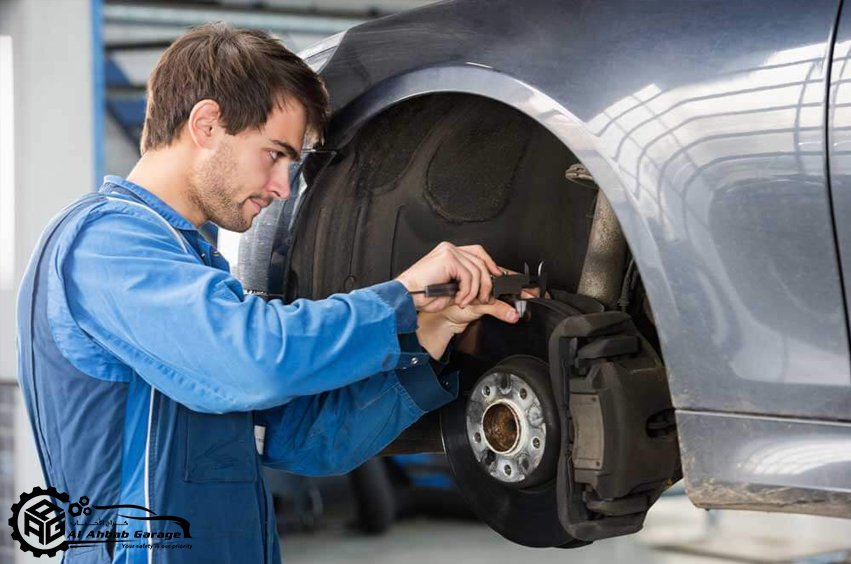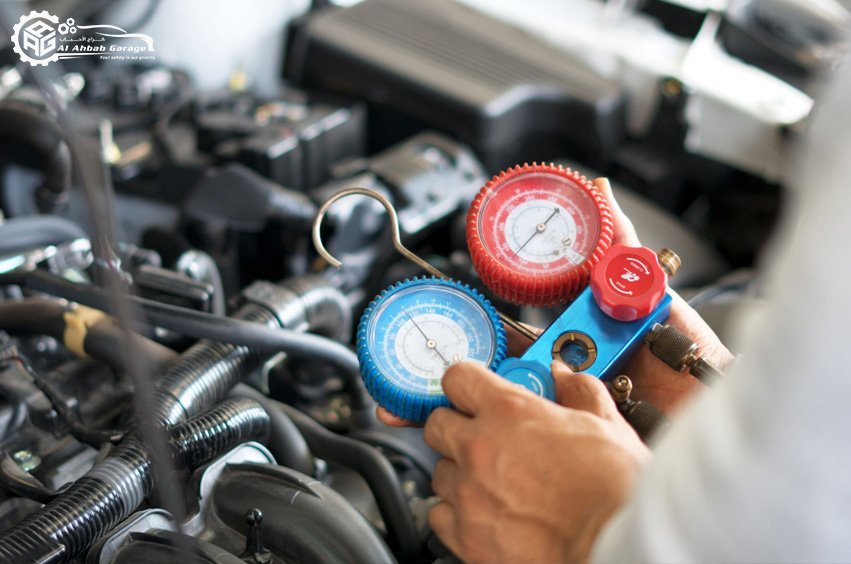
Brake Repair
A fully functioning brake system is crucial to your safety, the safety of your passengers, and the safety of other drivers on the road. Your vehicle’s brake system involves highly engineered parts and precise movements that stop your vehicle by converting kinetic energy into thermal energy. When you press down on the brake pedal, the master cylinder pressurizes a system of hydraulic brake lines leading to each of the vehicle’s wheels, where brake pads or shoes press against a disc or drum and create the necessary friction needed to slow the vehicle to a complete stop. Over time, this friction and heat has the potential to wear down the brake shoes, brake pads, calipers, brake rotors, and other braking components. While the components comprising each brake system may vary, the warning signs for impending brake repairs are the same.
Diesel Engine Repair
Built with durability, reliability, and optimization in mind, diesel engine systems are designed to use their own compression to ignite fuel. In gasoline engines, the fuel is mixed with air, compressed by pistons, and ignited by a spark plug. The rate of compression in a diesel engine is more than three times that of a regular gasoline engine system. In a diesel engine system, the air is compressed at a high compression ratio, which introduces a great amount of heat. Following this compression, fuel is directly injected into the cylinder, where the fuel vapor is ignited. Diesel engines are built without spark plugs. Instead, diesel systems use glow plugs to start and run more efficiently in colder temperatures. Glow plugs have two heating elements that allow them to get very hot very quickly for fast starts. Turbochargers increase the compression ignition by quickly compressing the air flowing into the engine, allowing for more air to flow into the chamber. More air in the combustion chamber means more fuel can be added to the combustion process. Turbochargers provide diesel engine systems with improved efficiency, and ultimately, more miles per gallon of diesel fuel.


Steering and Suspension System
The steering and suspension system on your vehicle is responsible for maintaining comfortable riding conditions and driving performance. The steering and suspension system also helps drivers remain in control of their vehicles at all times. The suspension system converts forward energy created by bumps in the road into vertical energy that travels up into the vehicle frame. Suspension system components, like coil springs and shock absorbers, help to dampen the impact of this road force. While the individual components comprising each suspension system may vary, all suspension system components will weaken over time through stress applied during normal driving conditions. Similarly, off-road driving and erratic driving can wear down suspension components more quickly. Regardless of your driving preferences, we have the necessary equipment to identify and correct any issue plaguing your steering and suspension system. Our staff is trained to inspect the steering and suspension components in order to determine whether your service will entail a minor adjustment or a replacement.
Axle, CV Joint, Driveshaft Repair
Your vehicle’s axle, CV joint, and driveshaft components are integral to the performance and drivability of your vehicle. The driveshaft is a steel or aluminum cylindrical component that connects the transmission to the rear differential. The driveshaft connects to the transmission through the CV joints, which are responsible for transferring the torque from the transmission to the drive wheels at a constant speed. Front wheel drive vehicles use CV joints on the front axles. CV joints allow the axle to bend and change while accommodating the bounce of the wheels. The axle bears the weight of the vehicle while also being strong enough to sustain the forces from braking and accelerating. Over time and through normal use, your vehicle’s axle, CV joint, and driveshaft components may require maintenance or replacement services.


Belts & Hoses
Your vehicle’s belts and hoses are involved in processes within the cooling system, air conditioning system, charging system, and engine. These belts and hoses play crucial roles in functional operations inside your vehicle. The heater hose and radiator hose carry liquid coolant to and from the engine, radiator, and heater core. The timing belt is responsible for maintaining engine precision by synchronizing the rotation of the crankshaft and camshaft, which move the engine’s valves and pistons. However, not all vehicles contain timing belts. In place of timing belts, some vehicles use timing chains. On the outside of the engine, the serpentine belt transmits power from the front of the engine to other systems in the vehicle, like the air conditioning system and charging system. Some factors that contribute to wear and tear on your belts and hoses include vehicle age, mileage, belt tension, hose clamp failure, electrochemical degradation, and oil contamination. In the long run, routine maintenance and replacements of your vehicle’s belts and hoses will prevent breakdowns and costly repairs.
Cooling System Repair
The cooling system consists of a cooling fan, water pump, thermostat, radiator, heater core, heater valve, and various other parts that primarily work together to dissipate and remove heat from a vehicle’s engine. Your vehicle’s cooling system is responsible for reducing the temperature inside your engine and preventing possible overheating. Excess heat can build in a variety of places in your vehicle’s engine. When the engine reaches maximum operating temperatures, the thermostat opens and releases antifreeze from the engine to the radiator, which initiates the circulatory flow to absorb excess heat. The antifreeze is also responsible for keeping other engine fluids from boiling or freezing. After the antifreeze flows through the engine, it cycles back to the radiator, where the excess heat escapes through the radiator’s walls. The antifreeze is cooled by the cooling fan and readied to be re-released into the engine to dissipate additional heat.


Differential Repair
The differential is responsible for transferring engine power to the wheels. It also compensates for and adjusts to the differences in wheel speed as your vehicle moves through turns. When your vehicle navigates a turn, the inside wheel turns slower than the outside wheel, which has to turn faster in order to keep pace with the inside wheel. The differential allows the wheels to turn at different speeds while maintaining control. A vehicle without a differential would hop and bump along the pavement for an unstable, shaky ride. Four wheel drive vehicles are equipped with a differential in front and back, while rear wheel drive vehicles are equipped with a differential in back. A front wheel drive’s differential, called the transaxle because of the functional combination of the front axle and transmission, is located between the front wheels. All-wheel drive vehicles are equipped with a differential between both the front and rear wheels with a transfer case between them. The case adjusts for speed differences between the front and rear wheels. In all vehicle applications, the differential is primarily responsible for routing and regulating power between wheels.
Engine Diagnostics and Performance
Every vehicle built since 1996 has been equipped with an On-Board Diagnostics System that monitors engine performance. Discrepancies in performance levels are reported through your vehicle’s computer system. Once the “check engine” or “service engine” light is displayed, your next step should be to seek out an engine diagnostic service or an engine tune-up. Engine diagnostics allow our staff to gather helpful information about the operating condition of your engine. The insights obtained during an engine diagnostic will determine the extent of suggested engine repairs. The most common diagnostic trouble codes are generated in response to malfunctions in the powertrain. Ultimately, regular engine tune-ups are necessary to optimize engine performance. A tune-up is also one of the most effective ways to prevent unexpected engine trouble. During an engine tune-up, our staff may replace the spark plugs, spark plug wires, air filter, fuel filter, and distributor cap and rotor in your vehicle. Our experts will also check emission levels, fuel lines, and belts and hoses. Engine diagnostics and regular engine tune-ups can help extend the life of your vehicle and improve the health of your engine.


Four Wheel Drive System
Four wheel drive systems allow all four wheels on a vehicle to spin simultaneously. All 4WD vehicles have a transfer case between the front and rear axles that prevents the axles from spinning at different speeds. The transfer case allows the engine to provide maximum torque to the axle and wheels in order to maintain traction. Different 4WD configurations exist, and each variation employs different technologies to meet the needs of the driver. Some 4WD systems have a locking differential. This means both wheels on the axle will turn together to achieve maximum traction. Another variation is the limited-slip differential. It can detect a slide or slip in one wheel and send torque to the other wheel to regain traction. A manual hub requires users to manually engage the front wheel drive mechanism in order to fully engage the 4WD system, while an automatic hub allows users to automatically command the front wheels in order to engage the 4WD system. Our service staff has extensive experience working on all types of 4WD systems.
Exhaust System Repair
Located on the underside of your vehicle, the exhaust system is responsible for collecting and directing harmful emissions away from the vehicle, reducing the amount of pollutants released into the environment, and minimizing engine exhaust noise and force. The exhaust system is composed of pipes and tubing designed to streamline vehicle operation while maximizing vehicle performance and efficiency. Engines produce dangerous gases as a byproduct of the combustion process. The exhaust manifold collects the emissions from the engine and funnels the gases through the front pipe to the catalytic converter. The converter transforms these harmful gases, like carbon monoxide, hydrocarbons, and nitrogen oxide, into less harmful ones, like oxygen, nitrogen, water vapor, and carbon dioxide. The muffler helps cancel out the noise created by the engine. The muffler dissipates sound waves while the tailpipe releases the converted gases into the atmosphere.
